
Military awards and decorations are distinctions given as a mark of honor for military heroism, meritorious or outstanding service or achievement. A decoration is often a medal consisting of a ribbon and a medallion.
To be mentioned in dispatches describes a member of the armed forces whose name appears in an official report written by a superior officer and sent to the high command, in which their gallant or meritorious action in the face of the enemy is described.
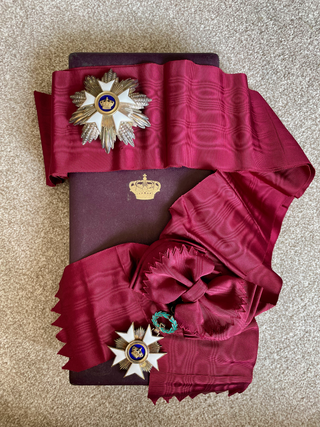
The Order of the Crown is a national order of the Kingdom of Belgium. The Order is one of Belgium's highest honors.

The Military William Order, or often named Military Order of William, is the oldest and highest honour of the Kingdom of the Netherlands. It is named after St. William of Gellone (755–814), the first Prince of Orange. Its motto is Voor Moed, Beleid en Trouw. The chivalric order was established on 30 April 1815 by King William I and was presented for feats of excellent bravery on the battlefield and as a meritorious decoration to senior military officers. Comparable with the French Légion d’Honneur but far less often awarded, it is open to everyone regardless of rank or nobility—not only to Dutch military, but also to foreigners. To date, membership in the Order is extremely rarely awarded, and only for exceptional bravery in battle.
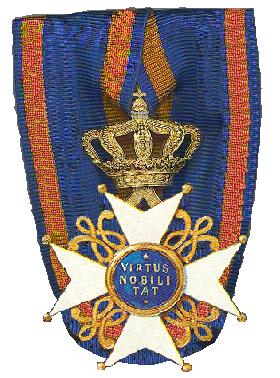
The Order of the Lion of the Netherlands, also known as the Order of the Netherlands Lion is a Dutch order of chivalry founded by King Willem I of the Netherlands on 29 September 1815.
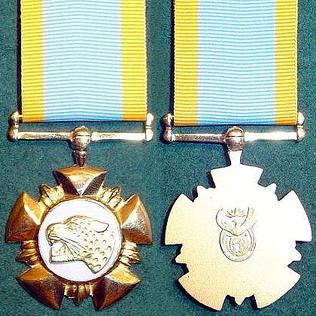
The Nkwe ya Gauta - Golden Leopard, post-nominal letters NG, is a military decoration for bravery which was instituted in 2003, to replace the Honoris Crux Gold (HCG). It is South Africa's highest military decoration for bravery.

The Nkwe ya Selefera - Silver Leopard, post-nominal letters NS, was instituted by the President of the Republic of South Africa on 16 April 2003 and came into effect on 27 April 2003. It is South Africa's second highest military decoration for bravery.
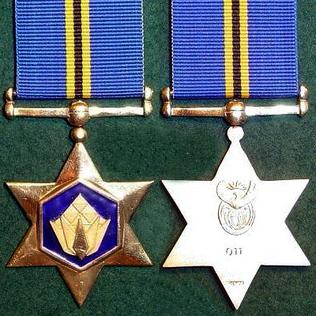
The iPhrothiya yeGolide - Golden Protea, post-nominal letters PG, was instituted by the President of the Republic of South Africa on 16 April 2003 and came into effect on 27 April 2003. It can be awarded to all ranks who have distinguished themselves by exceptional leadership or exceptional meritorious service and the utmost devotion to duty. It is South Africa's highest existing military decoration for meritorious conduct.
The orders, decorations, and medals of Canada comprise a complex system by which Canadians are honoured by the country's sovereign for actions or deeds that benefit their community or the country at large. Modelled on its British predecessor, the structure originated in the 1930s, but began to come to full fruition at the time of Canada's centennial in 1967, with the establishment of the Order of Canada, and has since grown in both size and scope to include dynastic and national orders, state, civil, and military decorations; and various campaign medals. The monarch in right of each Canadian province also issues distinct orders and medals to honour residents for work performed in just their province. The provincial honours, as with some of their national counterparts, grant the use of post-nominal letters and or supporters and other devices to be used on personal coats of arms.
Authorized foreign decorations of the United States military are those military decorations which have been approved for wear by members of the United States armed forces but whose awarding authority is the government of a country other than the United States.

Israeli military decorations are the decorations awarded to soldiers in the Israel Defense Forces who exhibit extraordinary bravery and courage. Its decorations consist of the Medal of Valor, the Medal of Courage, and the Medal of Distinguished Service. It also includes the Citations (Tzalash), which are awarded in four classes.
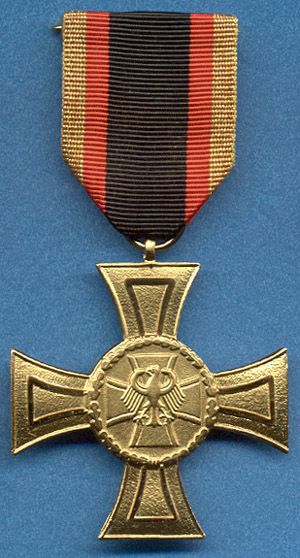
The Decorations of Honour of the Bundeswehr are a series of military decorations of the Bundeswehr, the armed forces of the Federal Republic of Germany. These honours and awards were introduced in 1980 on the occasion of the 25th anniversary of the Bundeswehr by then Minister of Defence Hans Apel and subsequently approved by President of the Federal Republic Karl Carstens.

The Louw Wepener Decoration, post-nominal letters LWD, is a military decoration for bravery which was instituted by the Union of South Africa in 1952. It was awarded to members of the South African Defence Force for acts of the most conspicuous courage or greatest heroism. The decoration was discontinued on 1 July 1975, when a new set of decorations and medals was instituted.
On 20 February 1941, the Dutch government in exile in London instituted several new awards for bravery. The new way that wars were fought, with civilian resistance and the merchant navy in great peril, made this necessary. Amongst the new decorations was the "Cross of Merit", an award for "working in the interest of the Netherlands while faced with enemy actions and distinguishing oneself through valor and resolute behavior". One did not have to be on the front line to win this award.
The Honorary Medal for Charitable Assistance was created at 18 June 1822 and is after the Military William Order the oldest decoration for bravery in the Kingdom of the Netherlands. Furthermore, the Honorary Medal is the highest civilian decoration still being awarded for bravery, and is specifically for those who carried out a voluntary act of bravery or self-sacrifice, with an emphasis on charity.

The Meritorious service medal for personnel of the Belgian Defence Forces and Foreign Armed Forces is a military decoration of Belgium. It was established on 23 February 2005 as a more rewarding successor of an earlier Medal of Military Merit and is awarded to members of the Belgian Armed Forces and civilians working for the Belgian Defence who show an exemplary meritorious behaviour in the completion of their duties or who have accomplished an exemplary meritorious act.
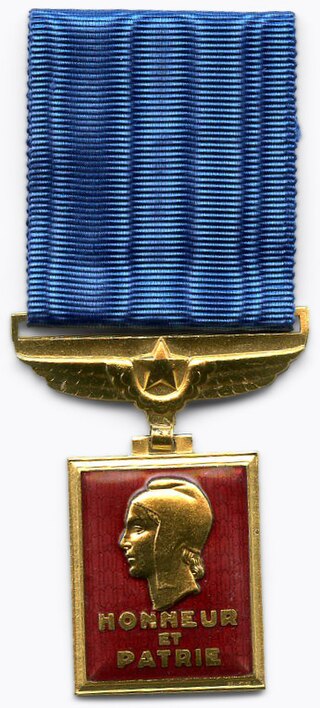
The Aeronautical Medal is a state decoration of France established by the decree of February 14, 1945. It is awarded to both military personnel and civilians for outstanding accomplishments related to the field of aeronautics. Originally envisioned before the Second World War, it was intended as an equal to the Order of Maritime Merit. The intent was to create an aerial order of merit intended for civilian and military personnel working in aeronautics. The war temporarily put an end to the project until February 1945.
This is a list of orders, decorations, and medals of Austria-Hungary.

The Gold Decoration for Merit, post-nominal letters GDM, was instituted by the President of the Republic of South Africa in April 1996. It was awarded to veteran cadres of the Azanian People's Liberation Army, the military wing of the Pan Africanist Congress, for outstanding service and utmost devotion to duty during the "struggle".













